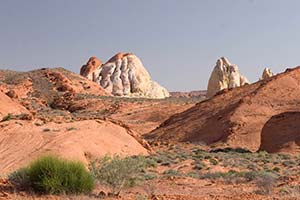 |
| Picturesque sand formations - Valley of Fire. |
 |
| Black sand. |
Most sand and gravel comprises the mineral quartz with varying amounts of feldspar, rock fragments, and other mineral materials. The commercial use of sand and gravel falls into two categories. Some is used in construction where it may be mixed with other materials or used as is. It is mined in every State usually within about 80 kilometers of its destination. The second use is industrial where the sand and gravel are used in some way in the production of other materials. Industrial sand and gravel is mined in about 37 States and is worth enough to be shipped much farther than construction sand and gravel. Industrial sand and gravel, which is often termed "silica," "silica sand," or "quartz sand," includes sand and gravel with high quartz content. Such sand and gravel is used, for example, in abrasive, foundry, glassmaking, and hydraulic fracturing applications. The specifications for each use differ, but silica resources for most uses are abundant. Construction sand and gravel typically has a lower silicon dioxide content than does industrial sand and gravel. It is mixed with other materials, such as cement in concrete foundations, roads, and buildings, or is used as is in road bases.
Background
Sand, whether it is found on beaches or in rivers and streams, is mostly quartz (silicon dioxide, SiO2) grains. The weathering of rocks such as granite forms these quartz grains. In the process of weathering, the softer, weaker minerals in granite (such as feldspar) are weathered away. The more resistant quartz eventually is ground down in size, but does not break down chemically. In time, these quartz grains accumulate in rivers, streams, deltas and on beaches. Grains of other weathering-resistant minerals (such as garnet, rutile, ruby, sapphire, zircon, etc.) are often found in quartz sand as well.
For some applications, it is the silica content (quartz) of sand that makes it so valuable. The silica itself is needed to make products such as glass. In addition, the physical properties of sand, particularly its abrasive property, make it useful for traction on icy roadways and railroads, and for sandblasting.
Sources
World resources of sand and gravel are very large. Recovering and processing these resources can be too costly depending on the location of a particular sand deposit and environmental laws about protecting or preserving the area. The sand and gravel deposits that have proven to be most valuable are from present and ancient river channels, river flood plains and glacial deposits.
Construction sand and gravel are produced in all 50 states in the U.S. The states producing the most are California, Texas, Michigan, Ohio, Arizona, Colorado, Minnesota, Washington, and Utah. Together, they produce 52% of the total amount of construction sand and gravel mined and processed in the United States. More than a billion tons of sand and gravel are produced annually in the U.S. As with many commodities, construction sand and gravel is also imported. These imports primarily come from Canada, but also from The Bahamas, Mexico, and assorted other nations.
Industrial sand and gravel are produced all over the world. The leading nations processing and producing industrial sand and gravel include the United States, Australia, Austria, Belgium, Brazil, Canada, France, Germany, India, Spain, Sweden, and South Africa. The United States is the world's leading exporter of silica sand. (Presently it is impossible to report how many tons of sand and gravel produced each year because each nation defines and processes "silica sand" differently.) Because of the extensive, high-quality deposits of sand, combined with the technology to process sand and gravel into nearly any quality for any application, sand and gravel companies in the U.S. are able to provide a product for any application. The U.S. exports sand and gravel to nearly every region of the world.
The United States is probably both the world's largest producer and largest consumer of sand and gravel. More than half of the US imports of industrial sand and gravel imports come from Australia, but also from Mexico, Canada, and other nations.
Uses
Specific percentages on the uses of construction sand and gravel are not available. This is because a little more than 50% of the sand and gravel consumed for construction is for "unspecified" purposes. However, it is reported that the remaining 50% is used to make concrete, for road construction, for mixing with asphalt, as construction fill, and in the production of construction materials like concrete blocks, bricks, and pipes. It is also used to make roofing shingles, on icy roads in the winter, railroad ballast and water filtration.
Industrial sand and gravel is used to make glass (39%), as foundry sand (22%), as abrasive sand (5%). The remaining 34% is used for an assortment of other uses.
Substitutes and Alternative Sources
Crushed stone is an alternative material for construction applications.
There are suitable substitutes for blasting (abrasive) sand, foundry and refractory applications, but not for glass making.